Durable Low-Friction Graphite Coatings Enabled by a Polydopamine Adhesive Underlayer
Abstract
1. Introduction
2. Materials and Methods
2.1. Materials
2.2. Sample Preparation
2.3. Tribological Testing
- 2-cycle tests (~20 s duration) to characterize initial sliding behavior and early-stage wear.
- 1 h tests to assess steady-state friction and wear resistance under prolonged cycling.
- Run-to-failure tests, where sliding continued until the COF exceeded 0.5, indicating coating failure. The time to failure was recorded as the coating lifetime.
2.4. Characterization
2.4.1. Morphology and Surface Topography
2.4.2. Elemental Analysis
2.4.3. Raman Analysis
2.4.4. X-Ray Photoelectron Spectroscopy (XPS) Analysis
3. Results and Discussion
3.1. Friction
3.2. Wear Track Morphology and Mechanisms
3.3. Elemental Analysis of Wear Tracks
3.4. Transfer Film and Counterface Wear
3.5. Raman Spectra Analysis
3.6. XPS Analysis
3.7. Summary of Wear Mechanisms
3.8. Broader Discussion
4. Conclusions
Supplementary Materials
Author Contributions
Funding
Data Availability Statement
Acknowledgments
Conflicts of Interest
References
- Scharf, T.W.; Prasad, S.V. Solid lubricants: A review. J. Mater. Sci. 2013, 48, 511–531. [Google Scholar] [CrossRef]
- Ayyagari, A.V.; Mutyala, K.C.; Sumant, A.V. Towards developing robust solid lubricant operable in multifarious environments. Sci. Rep. 2020, 10, 15390. [Google Scholar] [CrossRef] [PubMed]
- Berman, D.; Erdemir, A.; Sumant, A.V. Graphene: A new emerging lubricant. Mater. Today 2014, 17, 31–42. [Google Scholar] [CrossRef]
- Kumar, R.; Hussainova, I.; Rahmani, R.; Antonov, M. Solid Lubrication at High-Temperatures—A Review. Materials 2022, 15, 1695. [Google Scholar] [CrossRef]
- Torres, H.; Podgornik, B.; Jovičević-Klug, M.; Rodríguez Ripoll, M. Compatibility of graphite, hBN and graphene with self-lubricating coatings and tool steel for high temperature aluminium forming. Wear 2022, 490–491, 204187. [Google Scholar] [CrossRef]
- Podgornik, B.; Kosec, T.; Kocijan, A.; Donik. Tribological behaviour and lubrication performance of hexagonal boron nitride (h-BN) as a replacement for graphite in aluminium forming. Tribol. Int. 2015, 81, 267–275. [Google Scholar] [CrossRef]
- Rahman, M.M.; Islam, M.; Roy, R.; Younis, H.; AlNahyan, M.; Younes, H. Carbon Nanomaterial-Based Lubricants: Review of Recent Developments. Lubricants 2022, 10, 281. [Google Scholar] [CrossRef]
- Ouyang, J.H.; Li, Y.F.; Zhang, Y.Z.; Wang, Y.M.; Wang, Y.J. High-Temperature Solid Lubricants and Self-Lubricating Composites: A Critical Review. Lubricants 2022, 10, 177. [Google Scholar] [CrossRef]
- Wang, Z.; Fu, Q.; Wu, S. Effect of solid lubricant particles on the tribological properties of PTFE composites lubricated with natural seawater. J. Dispers. Sci. Technol. 2019, 40, 239–249. [Google Scholar] [CrossRef]
- Ye, S.; Zeng, X. Tribological properties of PTFE and PTFE composites at different temperatures. Tribol. Lubr. Technol. 2014, 70, 32–39. [Google Scholar] [CrossRef]
- Wang, R.; Zhang, F.; Yang, K.; Xiao, N.; Tang, J.; Xiong, Y.; Zhang, G.; Duan, M.; Chen, H. Important contributions of carbon materials in tribology: From lubrication abilities to wear mechanisms. J. Alloys Compd. 2024, 979, 173454. [Google Scholar] [CrossRef]
- Marcinauskas, L.; Mathew, J.S.; Milieška, M.; Aikas, M.; Kalin, M. Effect of graphite concentration on the tribological performance of alumina coatings. J. Alloys Compd. 2020, 827, 154135. [Google Scholar] [CrossRef]
- Ye, W.; Shi, Y.; Zhou, Q.; Xie, M.; Wang, H.; Bou-Saïd, B.; Liu, W. Recent advances in self-lubricating metal matrix nanocomposites reinforced by carbonous materials: A review. Nano Mater. Sci. 2024, 6, 701–713. [Google Scholar] [CrossRef]
- Ren, Y.; Zhang, L.; Xie, G.; Li, Z.; Chen, H.; Gong, H.; Xu, W.; Guo, D.; Luo, J. A review on tribology of polymer composite coatings. Friction 2021, 9, 429–470. [Google Scholar] [CrossRef]
- Wu, H.; Zhang, H.; Gao, A.; Gong, L.; Ji, Y.; Zeng, S.; Li, S.; Wang, X. Friction and wear performance of aluminum-based self-lubricating materials derived from the 3D printed graphite skeletons with different morphologies and orientations. Tribol. Int. 2024, 195, 109614. [Google Scholar] [CrossRef]
- Choudhury, D.; Niyonshuti, I.I.; Chen, J.; Goss, J.A.; Zou, M. Tribological performance of polydopamine + Ag nanoparticles/PTFE thin films. Tribol. Int. 2020, 144, 106097. [Google Scholar] [CrossRef]
- Pan, G.; Guo, Q.; Ding, J.; Zhang, W.; Wang, X. Tribological behaviors of graphite/epoxy two-phase composite coatings. Tribol. Int. 2010, 43, 1318–1325. [Google Scholar] [CrossRef]
- Morstein, C.E.; Dienwiebel, M. Graphite lubrication mechanisms under high mechanical load. Wear 2021, 477, 203794. [Google Scholar] [CrossRef]
- Al-Asadi, M.M.; Al-Tameemi, H.A. A review of tribological properties and deposition methods for selected hard protective coatings. Tribol. Int. 2022, 176, 107919. [Google Scholar] [CrossRef]
- Abe, A.; Zou, M. Enhanced Scratch Resistance of Graphite Coating Using a Polydopamine Adhesive Underlayer. Coatings 2025, 15, 690. [Google Scholar] [CrossRef]
- Tran, N.T.; Flanagan, D.P.; Orlicki, J.A.; Lenhart, J.L.; Proctor, K.L.; Knorr, D.B. Polydopamine and Polydopamine-Silane Hybrid Surface Treatments in Structural Adhesive Applications. Langmuir 2018, 34, 1274–1286. [Google Scholar] [CrossRef] [PubMed]
- Beckford, S.; Zou, M. Wear resistant PTFE thin film enabled by a polydopamine adhesive layer. Appl. Surf. Sci. 2014, 292, 350–356. [Google Scholar] [CrossRef]
- Liu, Y.; Ai, K.; Lu, L. Polydopamine and its derivative materials: Synthesis and promising applications in energy, environmental, and biomedical fields. Chem. Rev. 2014, 114, 5057–5115. [Google Scholar] [CrossRef] [PubMed]
- Ryu, J.; Ku, S.H.; Lee, H.; Park, C.B. Mussel-inspired polydopamine coating as a universal route to hydroxyapatite crystallization. Adv. Funct. Mater. 2010, 20, 2132–2139. [Google Scholar] [CrossRef]
- Zhang, M.; Mi, M.; Hu, Z.; Li, L.; Chen, Z.; Gao, X.; Liu, D.; Xu, B.; Liu, Y. Polydopamine-Based Biomaterials in Orthopedic Therapeutics: Properties, Applications, and Future Perspectives. Drug Des. Dev. Ther. 2024, 18, 3765–3790. [Google Scholar] [CrossRef]
- Guo, S.; Pang, C.; He, P.; He, X.; Ren, J.; Ouyang, L. Effective coating of polydopamine-mediated polyacrylamide on SiOx microparticles enables stable interface chemistry. Appl. Surf. Sci. 2024, 651, 159255. [Google Scholar] [CrossRef]
- Haidar, D.R.; Ye, J.; Moore, A.C.; Burris, D.L. Assessing quantitative metrics of transfer film quality as indictors of polymer wear performance. Wear 2017, 380–381, 78–85. [Google Scholar] [CrossRef]
- Ge, X.; Chai, Z.; Shi, Q.; Liu, Y.; Wang, W. Graphene superlubricity: A review. Friction 2023, 11, 1953–1973. [Google Scholar] [CrossRef]
- Tomanik, E.; Christinelli, W.; Souza, R.M.; Oliveira, V.L.; Ferreira, F.; Zhmud, B. Review of Graphene-Based Materials for Tribological Engineering Applications. Eng 2023, 4, 2764–2811. [Google Scholar] [CrossRef]
- Buzio, R.; Gerbi, A.; Bernini, C.; Repetto, L.; Vanossi, A. Graphite superlubricity enabled by triboinduced nanocontacts. Carbon 2021, 184, 875–890. [Google Scholar] [CrossRef]
- Qu, C.; Wang, K.; Wang, J.; Gongyang, Y.; Carpick, R.W.; Urbakh, M.; Zheng, Q. Origin of friction in superlubric graphite contacts. Phys. Rev. Lett. 2020, 125, 126102. [Google Scholar] [CrossRef]
- Jiang, Y.; Choudhury, D.; Brownell, M.; Nair, A.; Goss, J.A.; Zou, M. The effects of annealing conditions on the wear of PDA/PTFE coatings. Appl. Surf. Sci. 2019, 481, 723–735. [Google Scholar] [CrossRef]
- Zhao, Y.; Zou, M. Experimental investigation of the wear mechanisms of thin PDA/PTFE coatings. Prog. Org. Coat. 2019, 137, 105341. [Google Scholar] [CrossRef]
- Zhou, P.; Deng, Y.; Lyu, B.; Zhang, R.; Zhang, H.; Ma, H.; Lyu, Y.; Wei, S. Rapidly-deposited polydopamine coating via high temperature and vigorous stirring: Formation, characterization and biofunctional evaluation. PLoS ONE 2014, 9, e113087. [Google Scholar] [CrossRef]
- Ryu, J.H.; Messersmith, P.B.; Lee, H. Polydopamine Surface Chemistry: A Decade of Discovery. ACS Appl. Mater. Interfaces 2018, 10, 7523–7540. [Google Scholar] [CrossRef]
- Ferrari, A.C.; Robertson, J. Interpretation of Raman spectra of disordered and amorphous carbon. Phys. Rev. B 2000, 61, 14095–14107. [Google Scholar] [CrossRef]
- Lan, Y.; Zondode, M.; Deng, H.; Yan, J.A.; Ndaw, M.; Lisfi, A.; Wang, C.; Pan, Y.-L. Basic concepts and recent advances of crystallographic orientation determination of graphene by raman spectroscopy. Crystals 2018, 8, 375. [Google Scholar] [CrossRef]
- Ferrari, A.C. Raman spectroscopy of graphene and graphite: Disorder, electron-phonon coupling, doping and nonadiabatic effects. Solid State Commun. 2007, 143, 47–57. [Google Scholar] [CrossRef]
- Chen, G.; Zhao, J.; Chen, K.; Liu, S.; Zhang, M.; He, Y.; Luo, J. Ultrastable lubricating properties of robust self-repairing tribofilms enabled by in situ-assembled polydopamine nanoparticles. Langmuir 2020, 36, 852–861. [Google Scholar] [CrossRef]
- Zhang, W.; Yang, F.K.; Han, Y.; Gaikwad, R.; Leonenko, Z.; Zhao, B. Surface and tribological behaviors of the bioinspired polydopamine thin films under dry and wet conditions. Biomacromolecules 2013, 14, 394–405. [Google Scholar] [CrossRef] [PubMed]
- Ball, V.; Del Frari, D.; Michel, M.; Buehler, M.J.; Toniazzo, V.; Singh, M.K.; Gracio, J.; Ruch, D. Deposition Mechanism and Properties of Thin Polydopamine Films for High Added Value Applications in Surface Science at the Nanoscale. BioNanoScience 2011, 2, 16–34. [Google Scholar] [CrossRef]
- Vergari, L.; Quincey, J.; Meric de Bellefon, G.; Merriman, T.; Hackett, M.; Scarlat, R.O. Self-lubrication of nuclear graphite in argon at high temperature. Tribol. Int. 2023, 177, 107946. [Google Scholar] [CrossRef]
- Goyal, R.K.; Yadav, M. The Wear and Friction Behavior of Novel Polytetrafluoroethylene/Expanded Graphite Nanocomposites for Tribology Application. J. Tribol. 2013, 136, 021601. [Google Scholar] [CrossRef]
- Dienwiebel, M.; Pradeep, N.; Verhoeven, G.S.; Zandbergen, H.W.; Frenken, J.W.M. Model experiments of superlubricity of graphite. Surf. Sci. 2005, 576, 197–211. [Google Scholar] [CrossRef]
- Morstein, C.E.; Klemenz, A.; Dienwiebel, M.; Moseler, M. Humidity-dependent lubrication of highly loaded contacts by graphite and a structural transition to turbostratic carbon. Nat. Commun. 2022, 13, 5958. [Google Scholar] [CrossRef]
- Scheidt, H.A.; Filip, C.; Turcu, R.; Bende, A.; Beck, S. Structure of Polydopamine: A Never-Ending Story? Langmuir 2013, 29, 10539–10548. [Google Scholar] [CrossRef] [PubMed]
- Kim, Y.; Kim, J. Carbonization of polydopamine-coating layers on boron nitride for thermal conductivity enhancement in hybrid polyvinyl alcohol (PVA) composites. Polymers 2020, 12, 1410. [Google Scholar] [CrossRef] [PubMed]
- Seo, J.; Hyun, S.; Moon, J.; Yeong Lee, J.; Kim, C. High Performance of a Polydopamine-Coated Graphite Anode with a Stable SEI Layer. ACS Appl. Energy Mater. 2022, 5, 5610–5616. [Google Scholar] [CrossRef]
- Cortés, M.T.; Vargas, C.; Blanco, D.A.; Quinchanegua, I.D.; Cortés, C.; Jaramillo, A.M. Bioinspired Polydopamine Synthesis and Its Electrochemical Characterization. J. Chem. Educ. 2019, 96, 1250–1255. [Google Scholar] [CrossRef]
- Wang, D.D.; Gao, X.; Zhao, L.; Zhou, J.; Zhuo, S.; Yan, Z.; Xing, W. Polydopamine-coated graphene nanosheets as efficient electrocatalysts for oxygen reduction reaction. RSC Adv. 2018, 8, 16044–16051. [Google Scholar] [CrossRef]
- Yan, Q.; Xu, L.; Zhao, Y.; Wu, F.; Chen, R.; Li, L. Regenerated Graphite-Derived Cellular-Inspired Polydopamine@NiO@Graphite toward Robust Lithium Storage. ACS Appl. Mater. Interfaces 2023, 15, 25506–25515. [Google Scholar] [CrossRef]
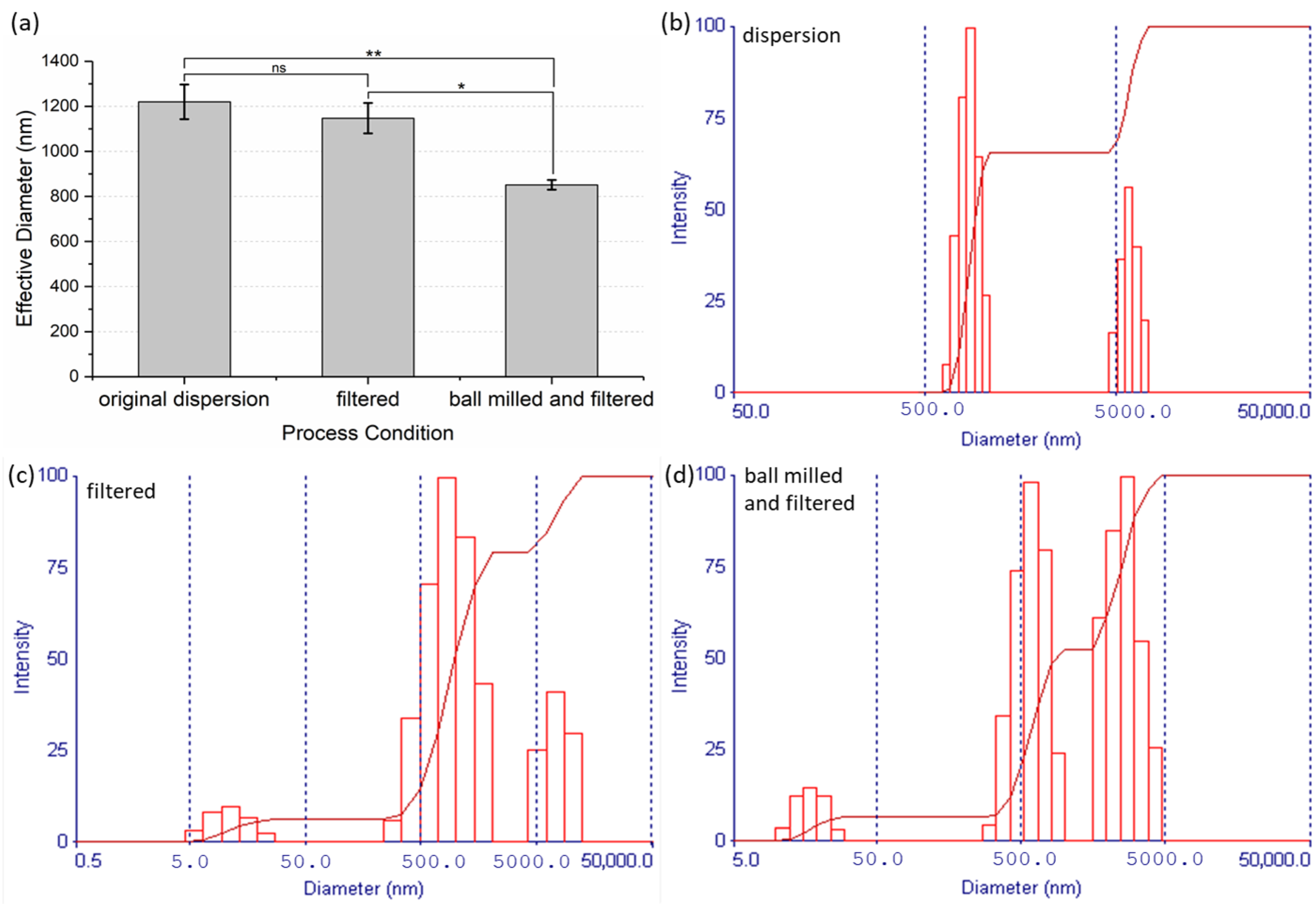
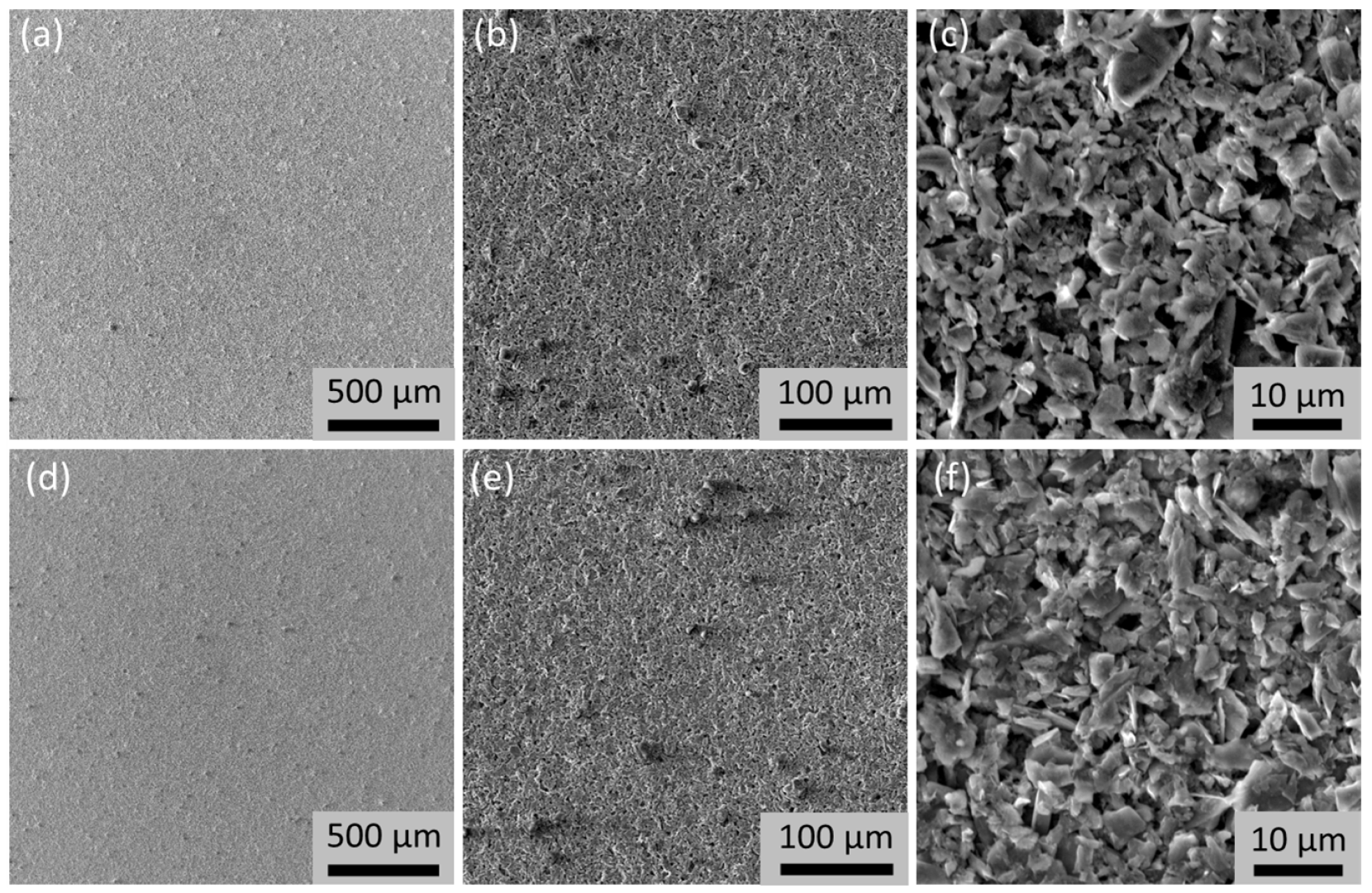
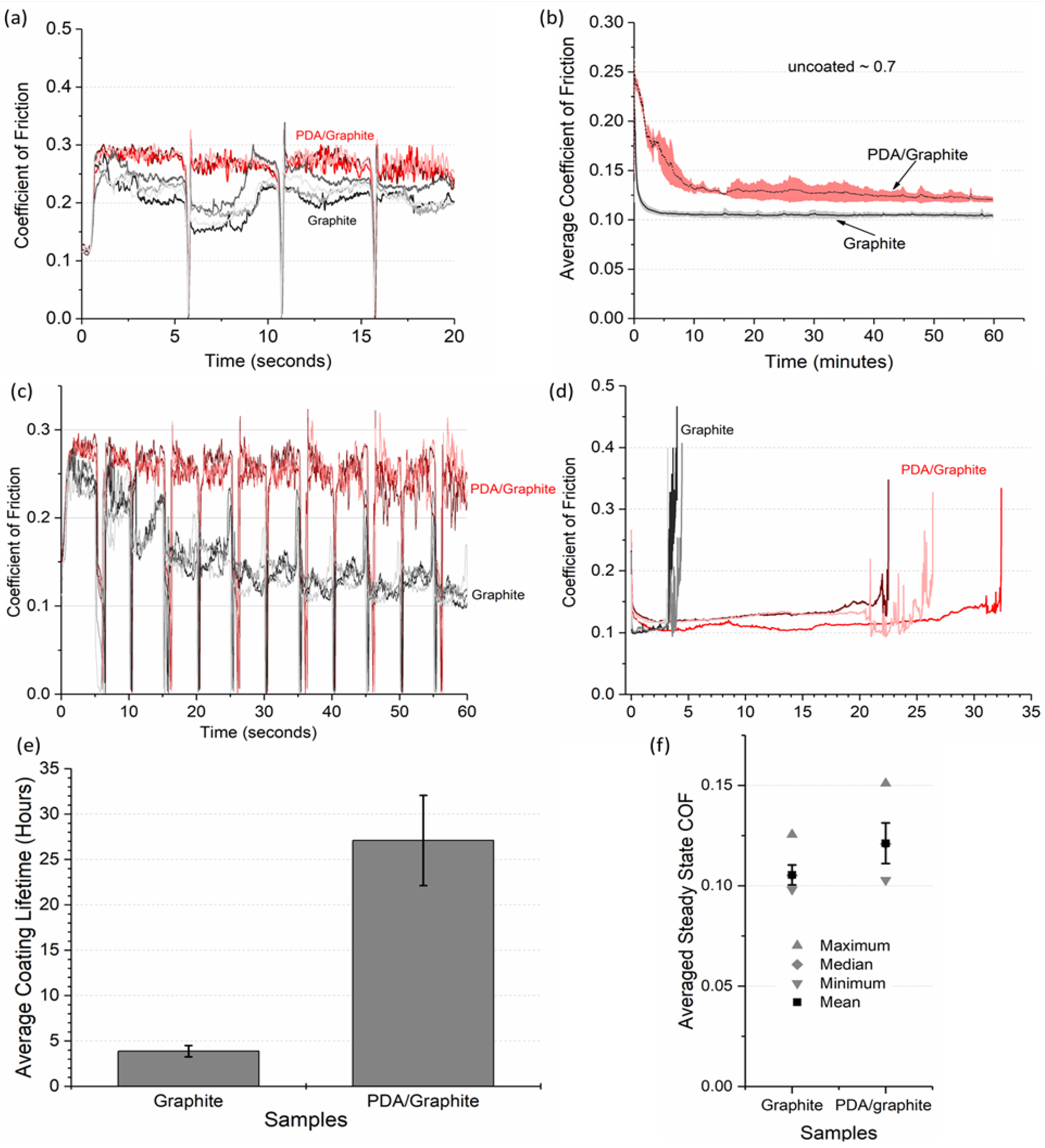
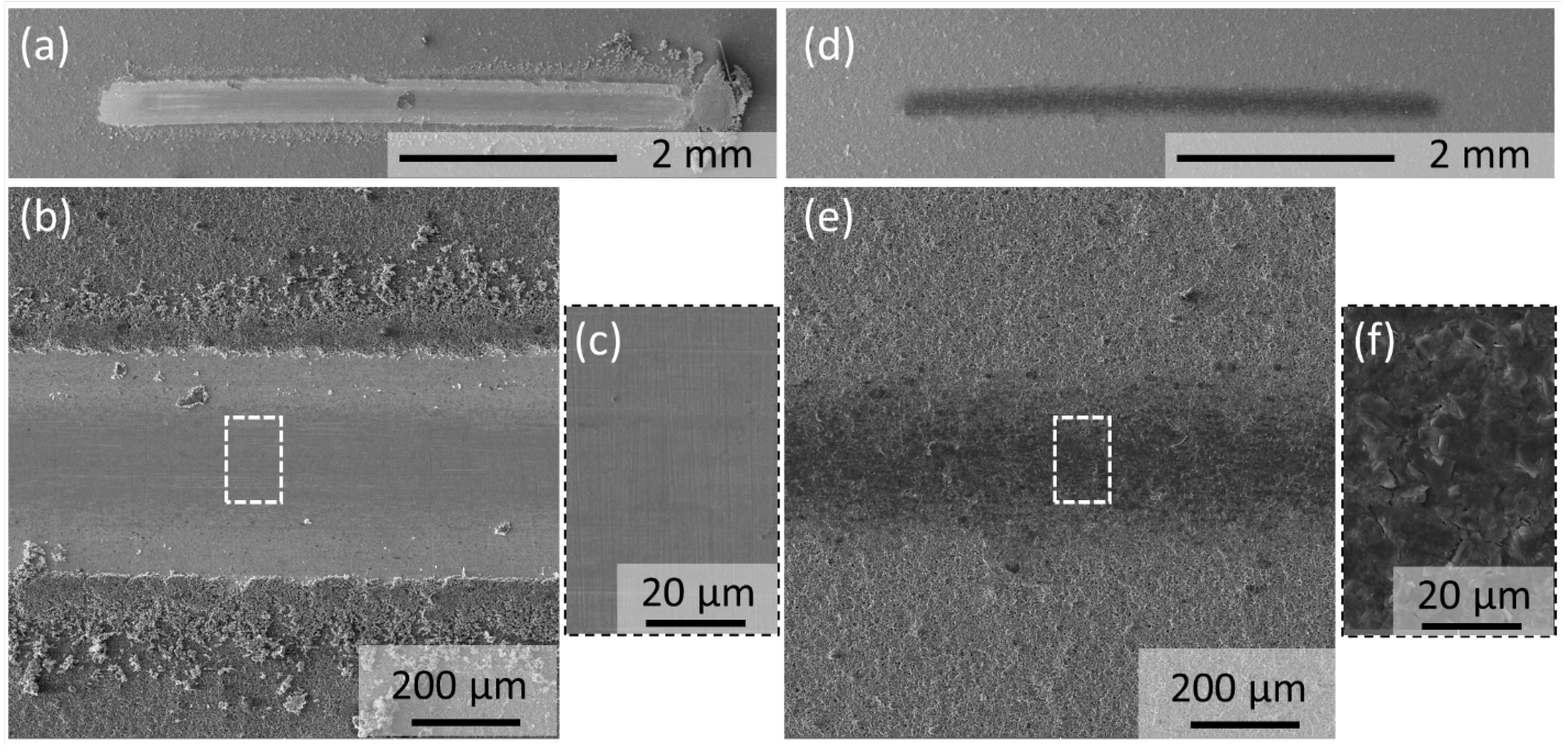
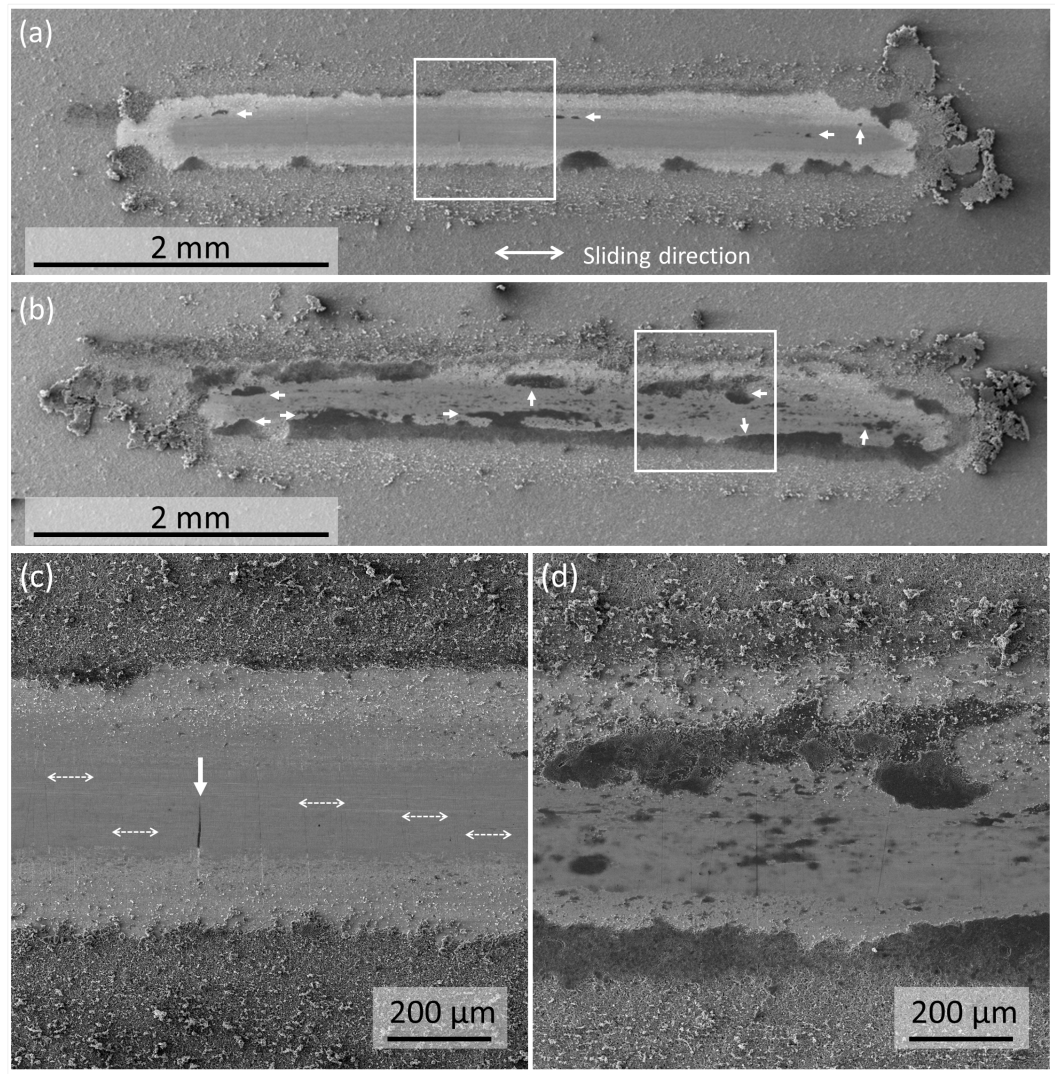
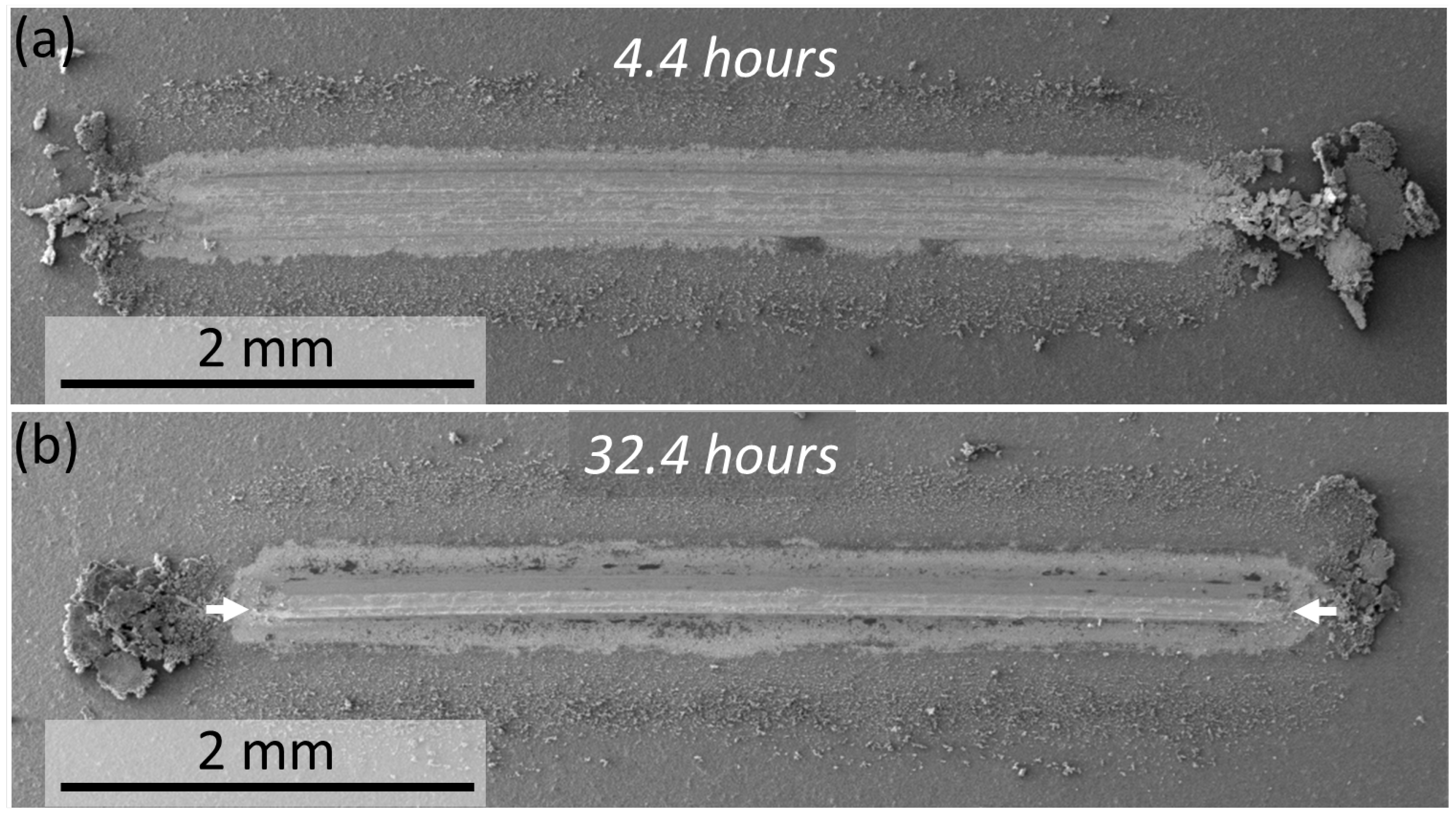
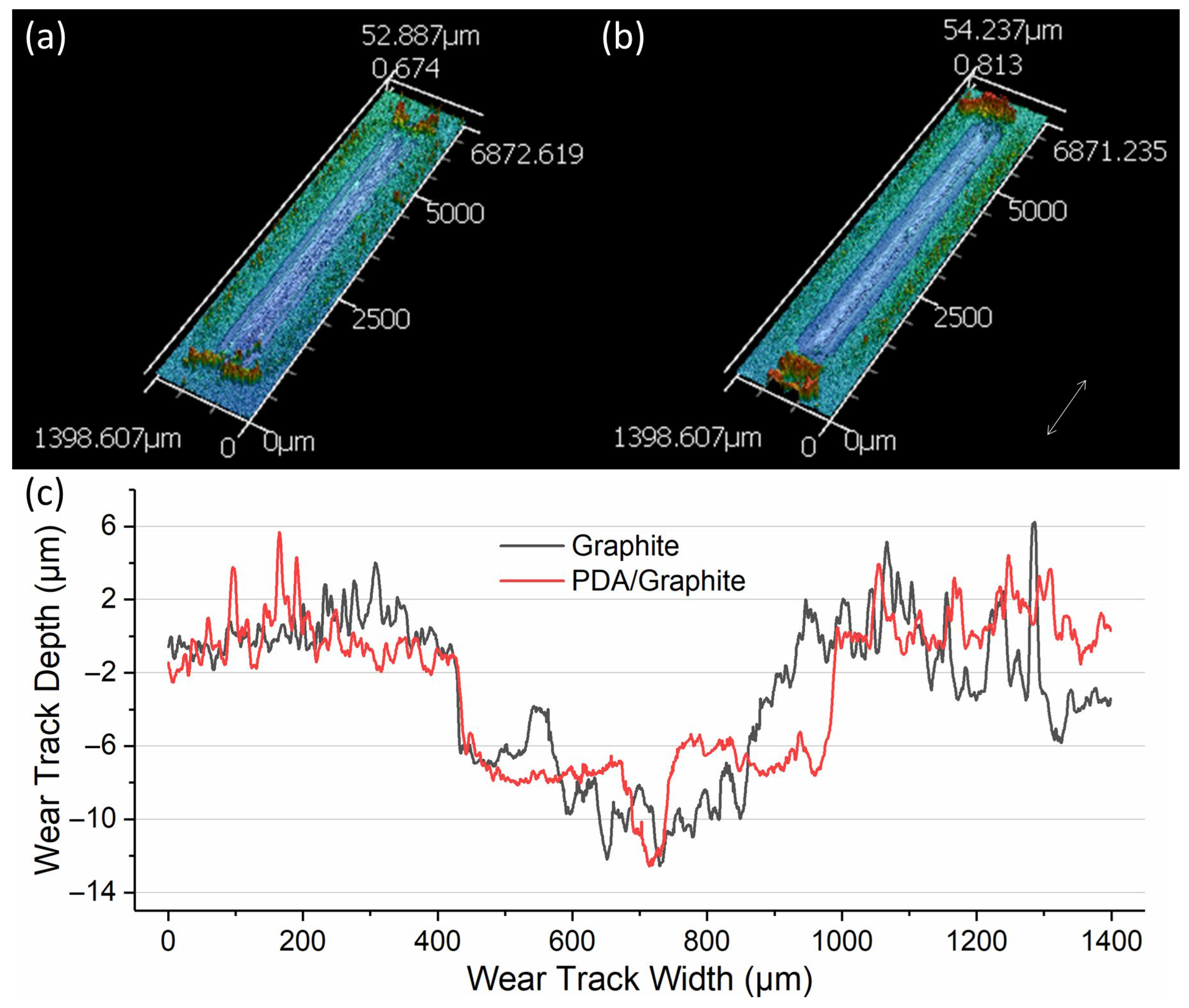
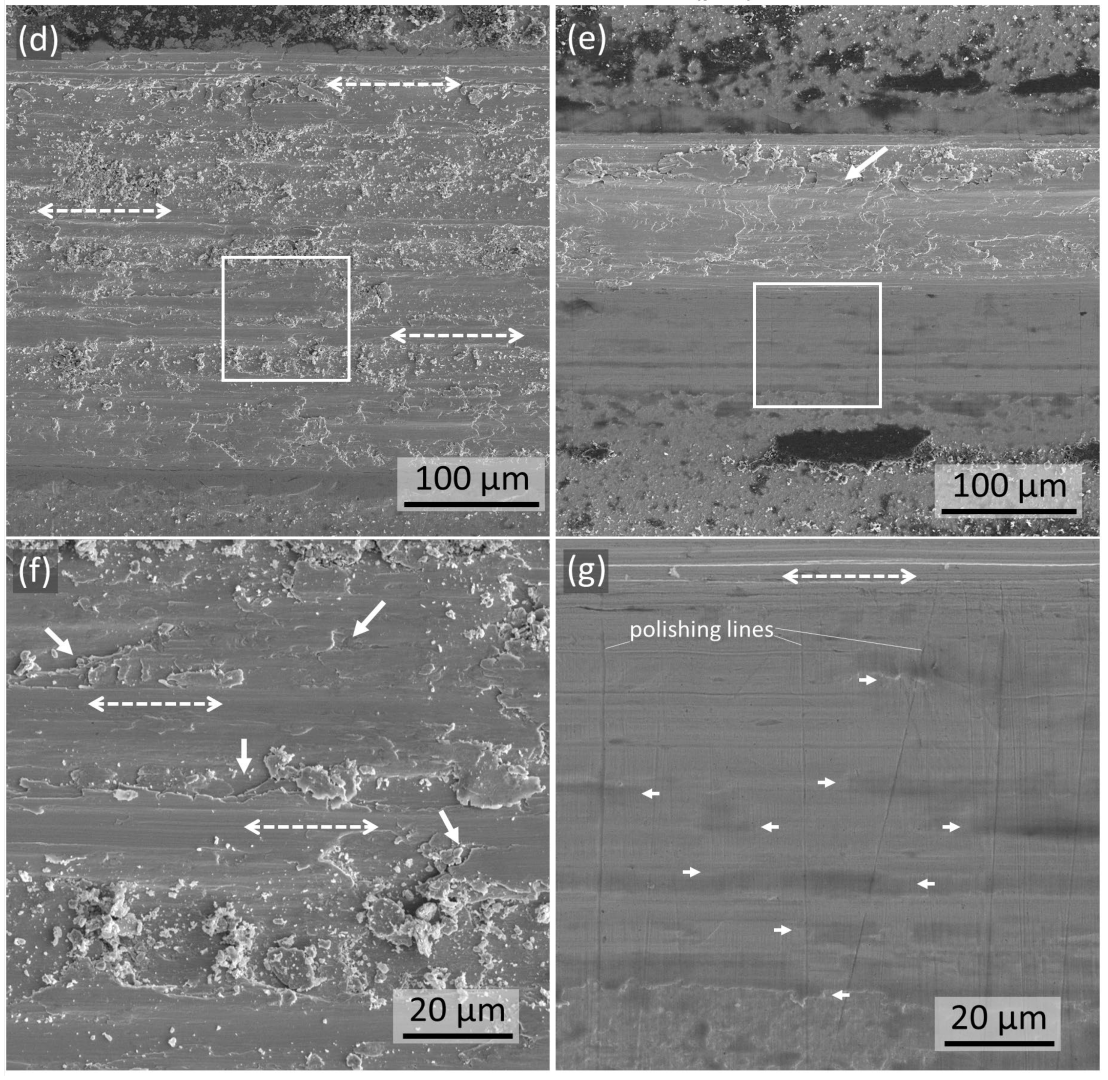
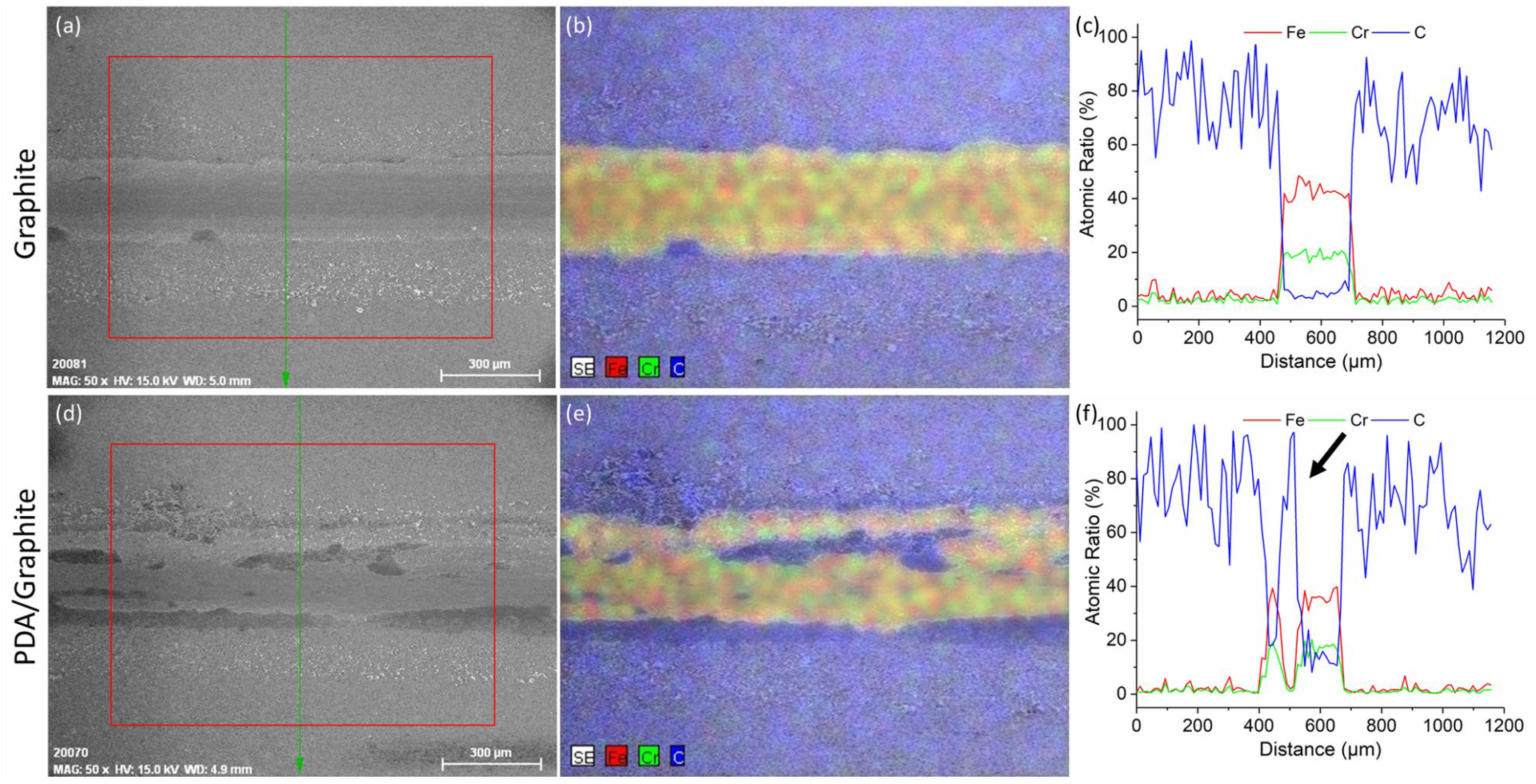
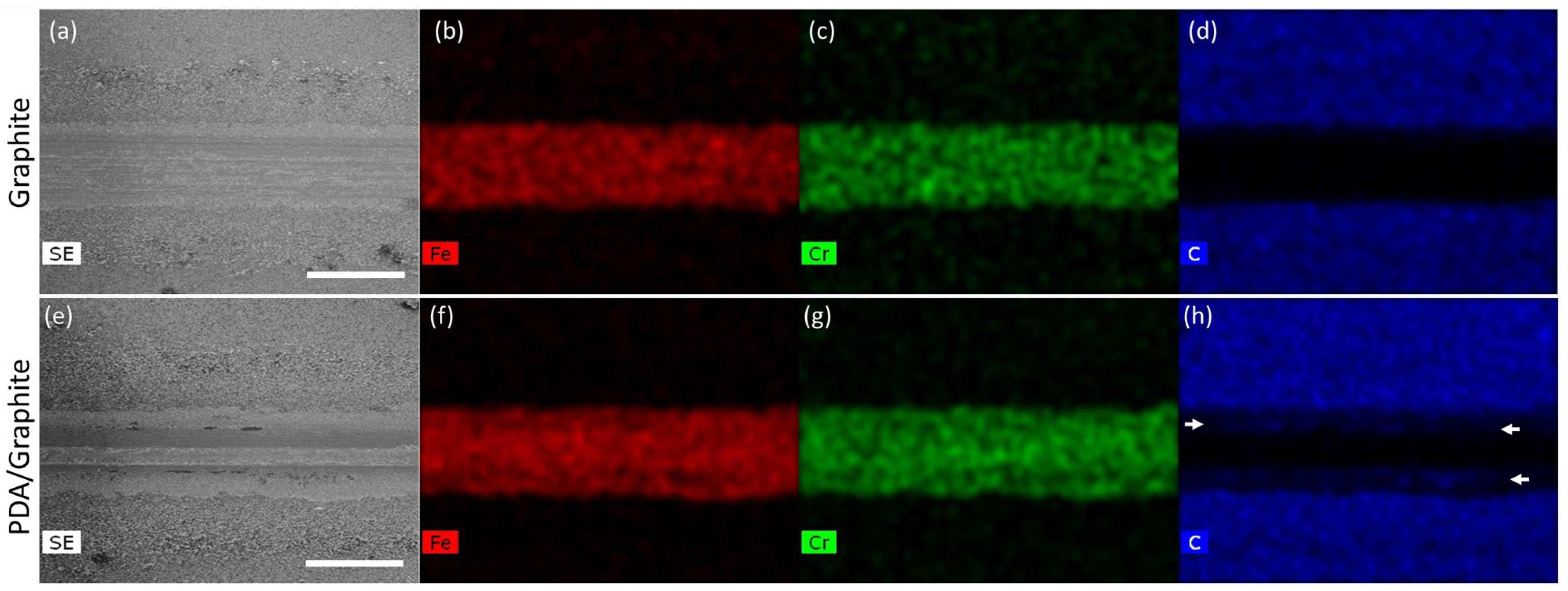
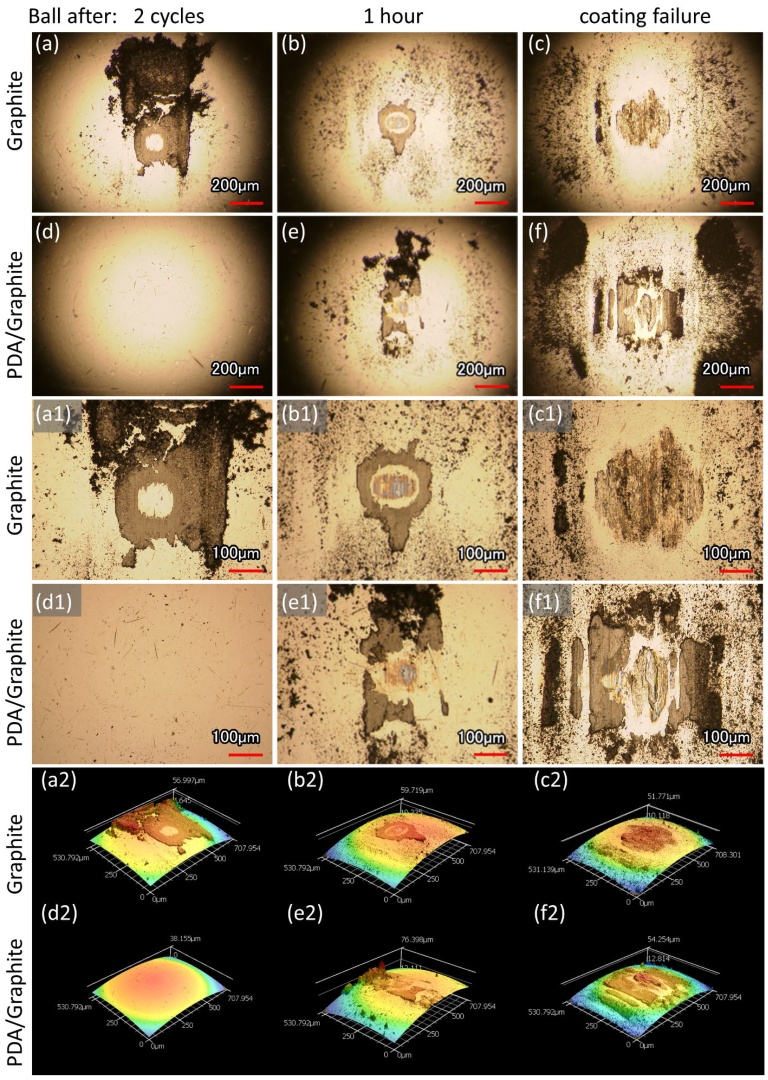
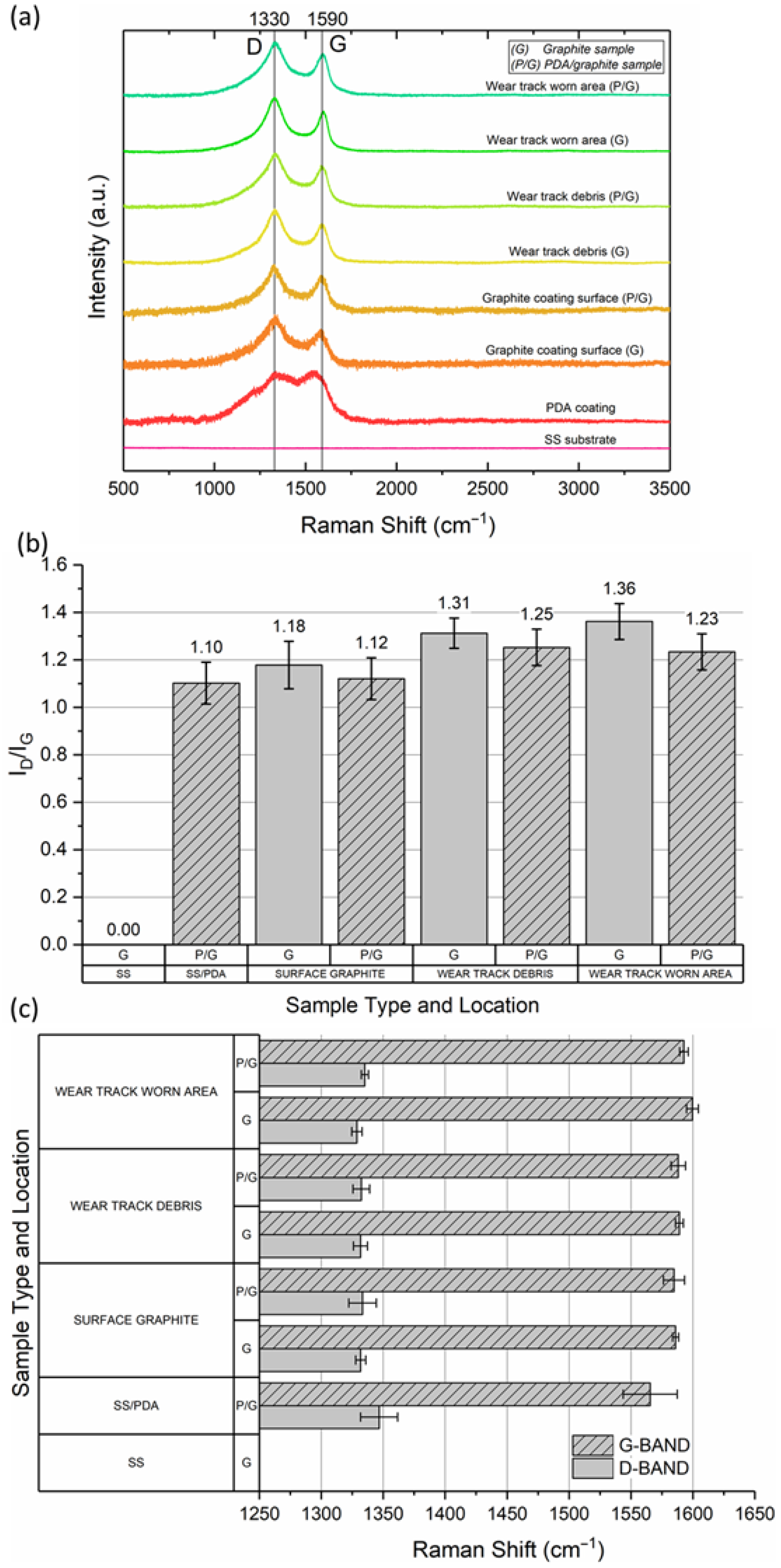
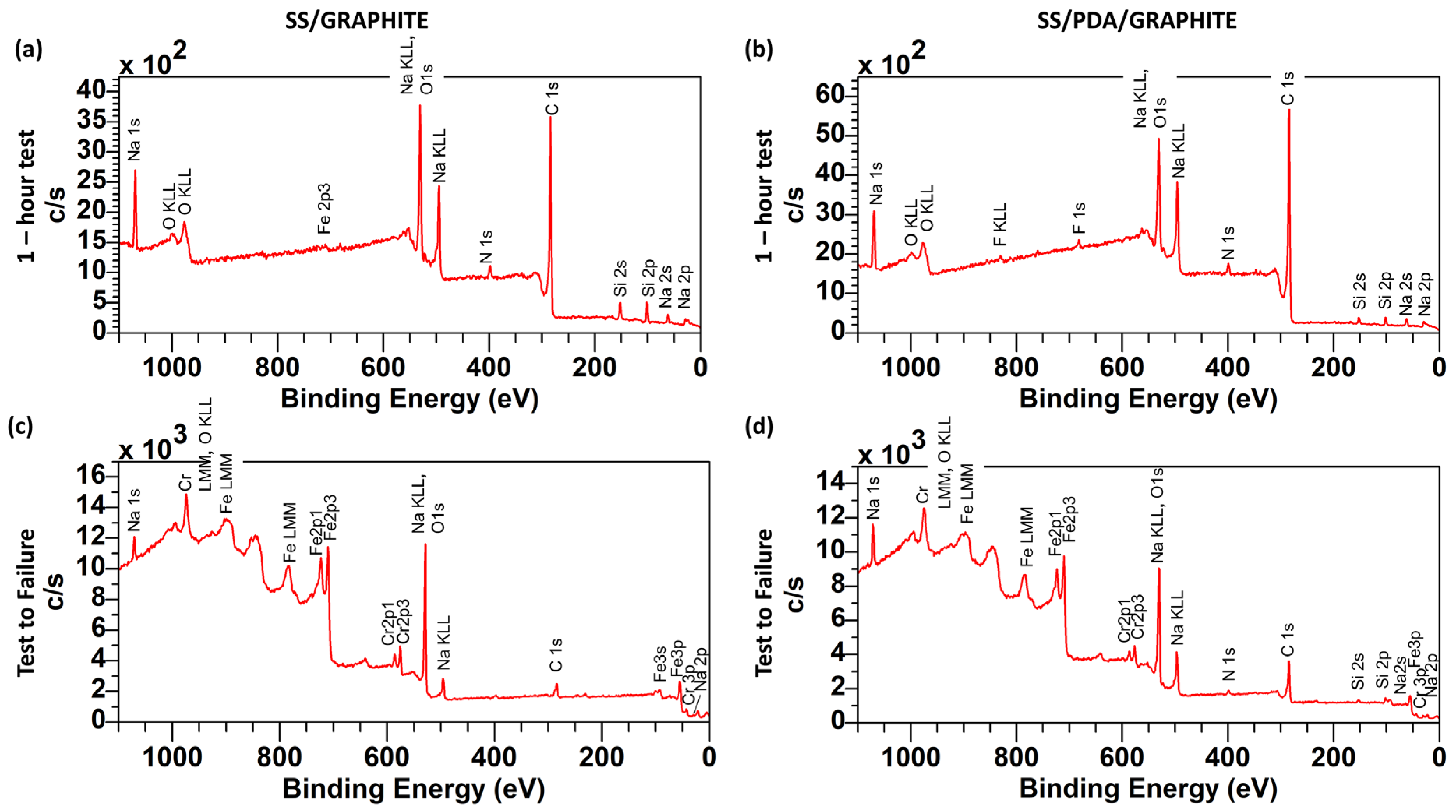
Disclaimer/Publisher’s Note: The statements, opinions and data contained in all publications are solely those of the individual author(s) and contributor(s) and not of MDPI and/or the editor(s). MDPI and/or the editor(s) disclaim responsibility for any injury to people or property resulting from any ideas, methods, instructions or products referred to in the content. |
© 2025 by the authors. Licensee MDPI, Basel, Switzerland. This article is an open access article distributed under the terms and conditions of the Creative Commons Attribution (CC BY) license (https://creativecommons.org/licenses/by/4.0/).
Share and Cite
Abe, A.; Maia de Oliveira, F.; Okyere, D.; Benamara, M.; Chen, J.; Mazur, Y.I.; Zou, M. Durable Low-Friction Graphite Coatings Enabled by a Polydopamine Adhesive Underlayer. Lubricants 2025, 13, 433. https://doi.org/10.3390/lubricants13100433
Abe A, Maia de Oliveira F, Okyere D, Benamara M, Chen J, Mazur YI, Zou M. Durable Low-Friction Graphite Coatings Enabled by a Polydopamine Adhesive Underlayer. Lubricants. 2025; 13(10):433. https://doi.org/10.3390/lubricants13100433
Chicago/Turabian StyleAbe, Adedoyin, Fernando Maia de Oliveira, Deborah Okyere, Mourad Benamara, Jingyi Chen, Yuriy I. Mazur, and Min Zou. 2025. "Durable Low-Friction Graphite Coatings Enabled by a Polydopamine Adhesive Underlayer" Lubricants 13, no. 10: 433. https://doi.org/10.3390/lubricants13100433
APA StyleAbe, A., Maia de Oliveira, F., Okyere, D., Benamara, M., Chen, J., Mazur, Y. I., & Zou, M. (2025). Durable Low-Friction Graphite Coatings Enabled by a Polydopamine Adhesive Underlayer. Lubricants, 13(10), 433. https://doi.org/10.3390/lubricants13100433





